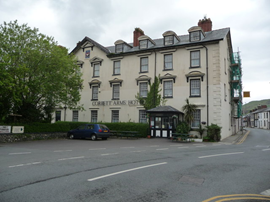Cautions or formal warnings in relation to potential listed building offences in England and Wales
This article was created by The Institute of Historic Building Conservation (IHBC). It was written by Bob Kindred MBE BA IHBC MRTPI and published in January 2016. You can see the original article on the IHBC website.
This short guidance note aims to clarify uncertainty about the current status of simple cautions or formal warnings in relation to potential listed building offences in England and Wales.
When it is evident that unauthorised work to a listed building may have taken place, one of the options open to the local authority is to issue a warning to the suspect. There may be uncertainty with potential listed building offences about the potential deterrent value (if publicised) and may not be appropriate in some circumstances.
It should be noted that formal cautions should only be used where the tests set out in the decision to prosecute are met. Cautions are not an appropriate tool in cases where evidential reasons would prevent a case from proceeding to court. Cautions form an admission of guilt and should therefore only be used where the defendant has admitted guilt, or states being prepared to do so.
The use of a caution has always been a non-statutory procedure [1] and the principles set out in 2006 in DCLG best practice guidance on prosecutions remain sound. [2] Cautions continue to be available as has been the case in the past.
The power to administer a caution is limited to the police and has no statutory basis, being a discretionary procedure based on successive Home Office guidance. The key point about a simple caution is that it may be disclosed in court and can be taken into account in sentencing for any future offence for which the recipient of the caution is subsequently prosecuted. [3]
A local authority can warn someone as to their future conduct but this is not a simple caution and cannot and does not have the same effect as one administered by the police, nor does it have the same effect in relation to sentencing for future offences. There is currently no national database of such warnings.
Although the Home Office Circular 30/2005 [4] dealing with the use and practical administration of simple cautions [5] has been cancelled - some of its general principles might be worth outlining for conservation professionals when considering what action to take.
If a local authority officer follows the rules relating to simple cautions that person must be satisfied that there is enough evidence to prosecute; the defendant would have to be prepared to admit guilt; there would need to be an evaluation of whether there were any mitigating factors; and the officer would have to be satisfied that, notwithstanding an admission, it is not in the public interest to prosecute.
Local authorities have discretion whether to prosecute listed building offences in any particular case, or issue a warning to an offender, and while there may be circumstances in which prosecution is not appropriate, the following questions need to be carefully considered:
- Did the officer have sufficient delegated authority to take the decision not to prosecute? [6]
- What were the officer’s reasons for concluding that it was not in the public interest to prosecute?
- Was the officer aware that the ’caution’ had no legal effect at all and was simply an admonition saying in effect ‘don’t do it again’?
For listed building offences a properly documented record should be made of an admission that an offence may have been committed with the details recorded by, for example, a PACE compliant tape recorded interview.
It is unlikely but not unknown for suspects to have received other reprimands for earlier similar offences elsewhere. Accordingly any other national or locally held records [7] [8] may need to be checked before a warning is given as this may determine if more formal proceedings should otherwise be instituted. If the suspect has previously received a relatively recent warning a further formal warning may not be appropriate. It would be necessary to decide whether the lapse of time had been sufficient to suggest whether or not a previous warning has had any deterrent effect.
The full implications of a warning should be explained to the suspect in writing once approved by the local authority. It should be administered by a suitably trained person within the authority being one to whom delegated powers have been granted (usually someone from the local authority’s legal service).
Local Planning Authorities should note that while Section 17 of the Criminal Justice and Courts Act 2015 merely restricts the circumstances in which a police constable can issue a caution – none of which are relevant to listed buildings – the Act is silent on the use of cautions by prosecuting authorities other than constables. The new guidance from the Ministry of Justice [9] explains how the police can use cautions but is silent as to their use by others - therefore it is considered that cautions remain a potentially useful tool for minor planning and heritage offences.
This is one of a series of occasional Guidance Notes published by The Institute of Historic Building Conservation (IHBC). The Notes necessarily reflect knowledge and practice at the time they were developed, while the ihbc.org.uk research@ihbc.org.ukIHBC always welcomes new case examples, feedback and comment to research@ihbc.org.uk for future revisions and updates.
Thanks for assistance in the compilation of this guidance are due to the IHBC Legal Panel, especially Nigel Hewitson, Dr Charles Mynors and John Campbell QC.
--Institute of Historic Building Conservation 07:53, 12 Jun 2016 (BST)
Related articles on Designing Buildings Wiki
- Alterations to listed buildings guidance note.
- Appeals against urgent works notices.
- Building Preservation Notice.
- Certificate of immunity.
- Charging for Listed Building Consent pre-application advice.
- Compulsory purchase orders for listed buildings.
- Conservation area.
- Conservation officer.
- Data sought for IHBC listed buildings prosecutions database.
- Designated areas.
- Ecclesiastical exemption.
- Enterprise and Regulatory Reform Act 2013 and listed buildings.
- Forced entry to listed buildings.
- Heritage partnership agreement.
- Historic England.
- Institute of Historic Building Conservation.
- Killian Pretty Review.
- Listed building.
- Listed Building Heritage Partnership Agreements.
- Local Listed Building Consent Orders.
- Listed Building Consent Order.
- Manor Farmhouse listed building prosecution.
- Negotiating skills for conservation professionals.
- Pre-application advice for planning permission.
- The valleys - past, present, future.
- Urgent works in advance of a listed building consent.
- Use of direct action in heritage enforcement cases in England.
- Use of injunctions in heritage cases in England and Wales.
Notes and references
- [1] http://webarchive.nationalarchives.gov.uk/20130125102358/http:/www.homeoffice.gov.uk/about-us/corporate-publications-strategy/home-office-circulars/circulars-2005/030-2005/.
- [2] Best Practice Guidance on Listed Building Prosecutions, Department of Communities and Local Government, December 2006. This guidance has been formally withdrawn but the material it contains remains relevant to good heritage management.
- [3] An example might include equipment installed by a contractor for which listed building consent was needed but where the installation contract made explicit that another party would obtain the necessary consent although the installer had undertaken the unauthorised work and would be likely to do similar such work in future.
- [4] Replacing earlier guidance from 1994.
- [5] For cases involving first time, low-level offences.
- [6] In many local authorities this would need to be a decision made – or at least confirmed – by elected members.
- [7] It has been the practice of some local authorities to co-ordinate information regarding crime across local authority boundaries under S.115 Disclosure of Information of the Crime & Disorder Act 1998.
- [8] The IHBC’s National Database of Listed Building Prosecutions may help provide some context for other offences elsewhere.
- [9] https://www.gov.uk/government/publications/simple-cautions-guidance-for-police-and-prosecutors
IHBC NewsBlog
Images from inside a Grade II listed hotel show the scale of its collapse
The Corbett Arms in Tywyn has fallen into serious disrepair.
Old Sarum fire in listed (& disputed) WW1 Hangar - Wiltshire Council has sought legal advice after fire engulfed a listed First World War hangar that was embroiled in a lengthy planning dispute.
UK Antarctic Heritage Trust launches ‘Virtual Visit’ website area
The Trust calls on people to 'Immerse yourself in our heritage – Making Antarctica Accessible'
Southend Council pledge to force Kursaal owners to maintain building
The Council has pledged to use ‘every tool in the toolbox’ if urgent repairs are not carried out.
HE’s Research Magazine publishes a major study of the heritage of England’s suburbs
The article traces the long evolution of an internal programme to research 200 years of suburban growth
IHBC Context 183 Wellbeing and Heritage published
The issue explores issues at the intersection of heritage and wellbeing.
SAVE celebrates 50 years of campaigning 1975-2025
SAVE Britain’s Heritage has announced events across the country to celebrate bringing new life to remarkable buildings.
IHBC Annual School 2025 - Shrewsbury 12-14 June
Themed Heritage in Context – Value: Plan: Change, join in-person or online.
200th Anniversary Celebration of the Modern Railway Planned
The Stockton & Darlington Railway opened on September 27, 1825.
Competence Framework Launched for Sustainability in the Built Environment
The Construction Industry Council (CIC) and the Edge have jointly published the framework.














